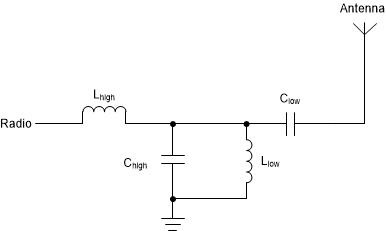SWRA640H December 2018 – May 2024 CC1310 , CC1312R , CC1314R10 , CC1350 , CC1352P , CC1352R , CC1354P10 , CC1354R10 , CC2620 , CC2630 , CC2640 , CC2640R2F , CC2640R2F-Q1 , CC2642R , CC2642R-Q1 , CC2650 , CC2652P , CC2652R , CC2652R7 , CC2652RB , CC2652RSIP , CC2674P10 , CC2674R10
- 1
- Abstract
- Trademarks
- 1 Reference Design
- 2 Front-End Configurations
- 3 Schematic
- 4 PCB Layout
- 5 Antenna
- 6 Crystal Tuning
- 7 TCXO Support
- 8 Integrated Passive Component (IPC)
- 9 Optimum Load Impedance
- 10PA Table
- 11Power Supply Configuration
- 12Board Bring-Up
- 13References
- 14Revision History
5.2 Dual-Band Antenna
The introduction of dual-band operation with advantages of Bluetooth Low Energy combined with long-range advantages of sub-1GHz sets the need of dual-band antennas. Separate antennas can be used for each of the bands, but physical space is normally limited on most handheld devices that promote usage of dual-band antennas. The most popular dual-band configurations are shown below:
- 863/928MHz and 2.4GHz
- 433-450MHz and 2.4GHz
- 470-510MHz and 2.4GHz
For dual-band operation that contains a low-band and a high-band, the antenna pi-match shown in Figure 5-1 is not recommended. It is recommended to use an LC, CL match network instead as shown in Figure 5-2. The LC part is used to match the high-band and the CL part is used for the low-band. Therefore, the LC section will be denoted as LHIGH CHIGH and the CL section as CLOW LLOW in order to identify the components.
 Figure 5-2 Recommended Antenna Match
Network for Dual-Band Antennas
Figure 5-2 Recommended Antenna Match
Network for Dual-Band Antennas